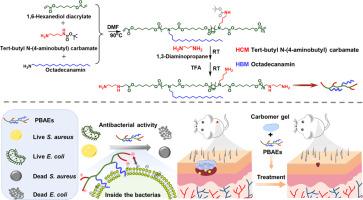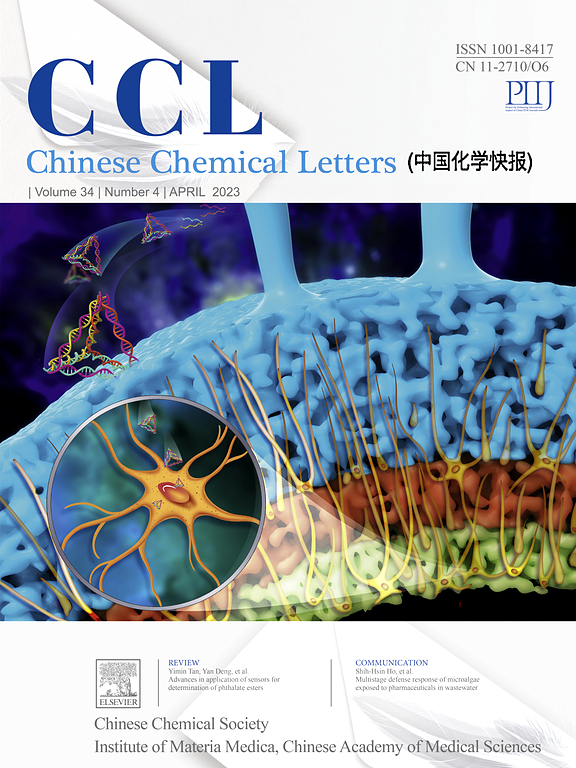The study of antibacterial activity of cationic poly(β-amino ester) regulating by amphiphilic balance
IF 9.4
1区 化学
Q1 CHEMISTRY, MULTIDISCIPLINARY
引用次数: 0
Abstract
It is well known that cationic polymers have excellent antimicrobial capacity accompanied with high biotoxicity, to reduce biotoxicity needs to decrease the number of cationic groups on polymers, which will influence antimicrobial activity. It is necessary to design a cationic polymer mimic natural antimicrobial peptide with excellent antibacterial activity and low toxicity to solve the above dilemma. Here, we designed and prepared a series of cationic poly(β-amino ester)s (PBAEs) with different cationic contents, and introducing hydrophobic alkyl chain to adjust the balance between antimicrobial activity and biotoxicity to obtain an ideal antimicrobial polymer. The optimum one of synthesized PBAE (hydrophilic cationic monomer :hydrophobic monomer = 5:5) was screened by testing cytotoxicity and minimum inhibitory concentration (MIC), which can effectively kill S. aureus and E. coli with PBAE concentration of 15 μg/mL by a spread plate bacteriostatic method and dead and alive staining test. The way of PBAE killing bacterial was destroying the membrane like natural antimicrobial peptide observed by scanning electron microscopy (SEM). In addition, PBAE did not exhibit hemolysis and cytotoxicity. In particular, from the result of animal tests, the PBAE was able to promote healing of infected wounds from removing mature S. aureus and E. coli on the surface of infected wound. As a result, our work offers a viable approach for designing antimicrobial materials, highlighting the significant potential of PBAE polymers in the field of biomedical materials.

通过两亲平衡调节阳离子聚(β-氨基酯)抗菌活性的研究
众所周知,阳离子聚合物具有优异的抗菌能力,但同时也具有较高的生物毒性,要降低生物毒性,就必须减少聚合物上的阳离子基团数量,这将影响抗菌活性。要解决上述难题,就必须设计出一种具有优异抗菌活性和低毒性的阳离子聚合物模拟天然抗菌肽。在此,我们设计制备了一系列阳离子含量不同的阳离子聚(β-氨基酯),并引入疏水烷基链来调节抗菌活性和生物毒性之间的平衡,从而获得理想的抗菌聚合物。通过细胞毒性和最低抑菌浓度(MIC)测试,筛选出合成的 PBAE 的最佳浓度(亲水阳离子单体与疏水单体的比例为 5:5),采用铺展平板抑菌法和死活染色测试,PBAE 浓度为 15 μg/mL 时可有效杀灭金黄色葡萄球菌和大肠杆菌。扫描电子显微镜(SEM)观察到,PBAE 的杀菌方式与天然抗菌肽一样,都是破坏菌膜。此外,PBAE 没有溶血和细胞毒性。特别是,从动物试验结果来看,PBAE 能够清除感染伤口表面的成熟金黄色葡萄球菌和大肠杆菌,从而促进感染伤口的愈合。因此,我们的工作为设计抗菌材料提供了一种可行的方法,凸显了 PBAE 聚合物在生物医学材料领域的巨大潜力。
本文章由计算机程序翻译,如有差异,请以英文原文为准。
求助全文
约1分钟内获得全文
求助全文
来源期刊

Chinese Chemical Letters
化学-化学综合
CiteScore
14.10
自引率
15.40%
发文量
8969
审稿时长
1.6 months
期刊介绍:
Chinese Chemical Letters (CCL) (ISSN 1001-8417) was founded in July 1990. The journal publishes preliminary accounts in the whole field of chemistry, including inorganic chemistry, organic chemistry, analytical chemistry, physical chemistry, polymer chemistry, applied chemistry, etc.Chinese Chemical Letters does not accept articles previously published or scheduled to be published. To verify originality, your article may be checked by the originality detection service CrossCheck.
 求助内容:
求助内容: 应助结果提醒方式:
应助结果提醒方式:


